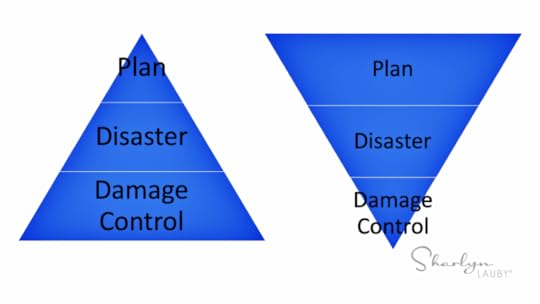How to Plan for an Organizational Emergency

Whether you’re a freelancer or a large
multinational organization, it’s important to have an emergency plan. It would
be wonderful to say that we don’t need to plan because nothing bad is going to
ever happen, but that’s just not very realistic.
No matter what type of business you operate,
you’re going to occasionally have to deal with an emergency. It could be a
natural disaster. Or maybe an accident. Possibly a scandal. Waiting until
something unexpected occurs to put a plan in place doesn’t make sense and could
actually cost the business more than the emergency created.
At WordCamp Orlando, one of the speakers gave
us a good outline for an emergency response plan. They used it in the context
of social media damage control, but I think the principles apply to any type of
emergency.
Plan! I love the pyramid image above to show the relationship between planning and response. A small amount of planning equates to a large amount of damage control. Want to reduce your exposure? Plan more. Detect.
This reminds me of my “seeing the dirt” story. Employees at every level of the
organization need to look for organizational vulnerabilities and report
suspicious or detrimental activity for investigation.Verify.
When an incident occurs, it’s important to verify what happened. In today’s
24-hour news cycle, it’s
easy to get caught up in rumors and speculation.
Take a moment to verify what took place. This doesn’t have to be a full-blown
investigation but do make sure that what people say is going on…is really going
on.Response.
Identify
in advance who the organization’s subject matter experts are.
When an emergency happens, call in the specialists. They should be prepared to
assist.Investigate.
This step works in concert with #3 Verify. The verify step is to confirm
there’s an emergency. In the investigation step, the organization needs to get
details – who was involved, what happened to cause the incident, where did it
take place, when did it happen, how did it happen, and finally why is it
happening.Communicate.
I cannot emphasize enough the value of giving the company’s spokespeople media
skills training. When an emergency strikes, the
community will want some sort of response. In addition, employees will want to
know what’s going on. Being able to communicate effectively – internally and
externally – is essential.Remediate.
Once the emergency has subsided, the
organization should conduct a debrief. Ask two
questions: A) What went well? And don’t say nothing. There will be things the
company does well. Even during a disaster. B) What could we do differently or
better next time? Please note I didn’t say “wrong” because….Review.
And update the plan accordingly. In the last bullet #7 Remediate, I mentioned
doing things differently next time. It’s possible that the company didn’t do
anything wrong. You followed your plan to perfection. But that doesn’t mean you
won’t want to make your plan stronger for the next time. Because chances are…
There will be a next time.
Emergency and disaster planning can help us
understand our organization. They can help employees prepare for the
unexpected. And they can make our operations stronger. The time and resources
we spend planning will help us at a future date. Make the investment. Your
employees and your business will thank you for it.
The post How to Plan for an Organizational Emergency appeared first on hr bartender.






Sharlyn J. Lauby's Blog
- Sharlyn J. Lauby's profile
- 10 followers



